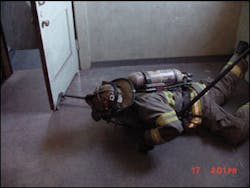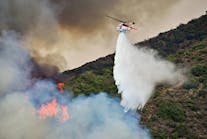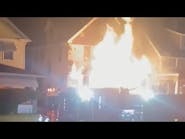Firefighters arrive at the scene of a 3-story residential townhome with a fire on the first floor. The fire appears to be nothing more than a room and contents fire and the engine company is stretching a line for what seems to be a routine fire?hopefully. A civillian appears on the side of the building saying someone is trapped on the second floor; they just saw them at a window of a bedroom. A firefighter grabs a portable ladder and raises it to the 2nd story window to perform a search.
Any time a member enters a window to do a search and conditions are severe or have the possibility of becoming severe, they must do a few things to protect themselves. Entering a window should always be done with another firefighter, if possible. In today's fire service the proper number of firefighters may not be available due to budget cuts, manning issues and EMS. These issues are undeniable and in the case of the fire problem stated above, entry has to be made, because of the "known life hazard." So how would you protect yourself or train one of your newer firefighters to make this search?
First and foremost, locating the bedroom door. If member uses a ladder for access into the room, he should clear the window completely to allow for emergency egress from that window, if required. How can a member keep in contact with the window as they find the door? If the member brings a six-foot hook or pike pole with them when they enter the window and another tool(such as a halligan or axe) they will then have the ability to reach the door in most residential bedrooms.
The hook can be hooked on to the windowsill and used as an anchor point, leading the member back to the window, if necessary. The firefighter then has a six-foot hook on their body and a search tool to make the door. The doors in residential bedrooms are usually located across from the window, to allow for ventilation of the room, unless the room is a corner bedroom.
Corner bedroom doors are usually located on the wall leading to the long side of the home, in the corner of the two interior walls. Once the member locates the door, they will assess fire conditions in the hallway prior to closing the door. If the door is closed then it should be temporarily opened for two reasons.
The first reason is to assess the conditions in the hallway of the second floor. This will give us an idea of how much fire is on the first floor and how long we can safely operated above the fire if the fire is not promptly extinguished.
The second reason is that people tend to try to use the same way in and out of a home that they have used for the entire time they lived there. They will try to make it down the stairs to the front door and sometimes will be overcome in the hallway of the second floor. In this case we have found the victim and can remove them to the bedroom, close the door and begin the rescue from there.
Once the door is located and checked the member can begin a search of the room. If they are at the door they can begin the search from there or use the hook to return to the window and begin their search from the window. By leaving the tool on the windowsill the members now have a point of reference in the room being searched.
As a reference point, the member can easily find the tool and a safe point of egress from the room. Then utilizing the other tool, the member will be able to quickly perform a search of the room. Firefighters should always have a tool with them when they are searching in a fire situation. The tool will help you get out of trouble and will allow to extend your reach do a faster and more thorough search.
Remember searching above the fire is dangerous and risky. Therefore, before entering a window, do a personal size-up and risk assessment to determine if you are going to be able to safely enter the window. If your safety is in question, then find another way to do the search or wait for the engine company to get water on the fire.
A firefighter entering a window is operating remote from the main fire attack. He must be able to communicate and determine the conditions they might be exposed to and evaluate them before entering the window. This comes with experience and that might not be available on every run, so always let command and your officer know if you are entering a window from the exterior. They should also evaluate the present fire conditions from their location and advise if it is too risky.
Training and fireground communication is the key to searching safely above a fire. Utilizing your hook on the windowsill, as an orientation point, they might lessen the chances of getting lost or turned around in a hot smoky room.
Michael M. Dugan is a 17-year veteran of the FDNY, serving as a Captain of Ladder 123 in Brooklyn?s Crown Heights. He has been involved with the Fire Service for 27 years. He is also a ?HOT? instructor at the ?Firehouse Expo.? He is a contributing editor to ?Firehouse? magazine. While assigned as a firefighter in Ladder Company 43, Dugan received the James Gordon Bennett medal in 1992 and the Harry M. Archer Medal in 1993, the FDNY?s highest award for bravery.If you have any questions regarding this subject area, Mike can be contacted at: [email protected]






